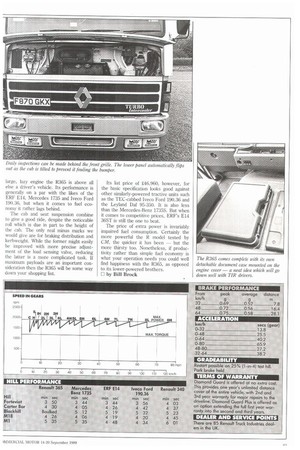ROADTEST RENAULT R365
Page 62

Page 63

If you've noticed an error in this article please click here to report it so we can fix it.
A crawler gear makes restarting on any steep incline up to a 25% (1-in-4) gradient very easy, and we were grateful for it on an 18% (1-in-6) section of the A68 where road works brought us to a halt.
Roads worn smooth and wet weather combined to make some of the steeper climbs slippery enough to cause loss of traction. As one or the other drive wheels began to spin we lost speed and came close to over-revving the engine on several occasions. It became a delicate balance between applying sufficient throttle to enable the vehicle to climb the hill, and keeping revs low enough to maintain grip.
On a dry track at MIRA's proving ground, full brake applications gave a good level of retardation — but at the same time highlighted a tendency for the R365's drive axle wheels to lock up. Fortunately, the wheels on the steering axle continued to rotate, and with some steering correction the vehicle came to rest only slightly out of line.
The semi-trailer brakes also worked hard, but the Skidchek anti-lock maintained control throughout the braking tests, allowing the wheels to just go into lock before releasing partially to minimise tyre wear and ensure stability.
Air suspension, both on the trailer and the tractive unit's drive axle, adds to the quality of the ride. The steering axle, suspended on parabolic leaf springs, gives positive reaction throughout the speed range but is affected slightly by cab roll during major manoeuvres.
Inevitably, environmental considerations will have an increasing influence on future truck development. The R365 is very quiet inside the cab and there were no signs of black smoke on the outside. The silencer, mounted on the nearside, offers some consideration to pedestrians by directing exhaust fumes towards the middle of the vehicle.
Usual daily inspections and fills are grouped together below the front grille. In tilting the cab, the lower front panel automatically flips out to clear the front bumper. At its full 700 tilt angle most of the ancillaries are put within easy reach.
A high-capacity air cleaner has been introduced to give improved engine breathing and reduce maintenance. Routine service intervals on R range models have also been extended to 15,000km and oil changes to 30,000km. Large, lazy engine the R365 is above all else a driver's vehicle. Its performance is generally on a par with the likes of the ERF E14, Mercedes 1735 and Iveco Ford 190.36, but when it comes to fuel economy it rather lags behind.
The cab and seat suspension combine to give a good ride, despite the noticeable roll which is due in part to the height of the cab. The only real minus marks we would give are for braking distribution and kerbweight. While the former might easily be improved with more precise adjustment of the load sensing valve, reducing the latter is a more complicated task. If maximum payloads are an important consideration then the R365 will be some way down your shopping list, Its list price of £46,960, however, for the basic specification looks good against other similarly-powered tractive units such as the TEC-cabbed Iveco Ford 190.36 and the Leyland Daf 95-350. It is also less than the Mercedes-Benz 1735S. But when it comes to competitive prices, ERF's E14 36ST is still the one to beat.
The price of extra power is invariably impaired fuel consumption. Certainly the more powerful the R model tested by CM, the quicker it has been — but the more thirsty too. Nonetheless, if productivity rather than simple fuel economy is what your operation needs you could well find happiness with the R365, as opposed to its lower-powered brothers.
0 by Bill Brock






















































































































































